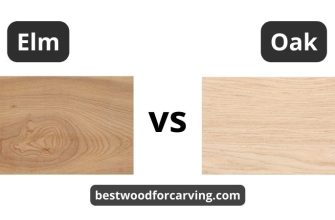Sapele and walnut wood are two distinct materials widely used in woodworking, each boasting unique qualities and characteristics.
![Sapele vs. walnut wood [5 main differences] sapele vs. walnut](https://bestwoodforcarving.com/wp-content/uploads/2024/01/woodd-3.jpg)
- 1. Appearance: Sapele vs. walnut wood
- Comparison
- 2. Durability: Sapele vs. walnut wood
- Comparison
- 3. Workability: Sapele vs. walnut wood
- Comparison
- 4. Aesthetic and applications: Sapele vs. walnut wood
- Comparison
- 5. Environmental impact: Sapele vs. walnut wood
- Comparison
- Strengths and weaknesses
- Sapele
- Walnut
- Comparison
- Conclusion
- FAQ
- What is the difference between Sapele and walnut color?
- Is Sapele a good wood?
- What are the advantages of Sapele?
- What is another name for Sapele wood?
- What is black walnut?
- What is better black walnut or English walnut?
- Is black walnut pricier than walnut?
1. Appearance: Sapele vs. walnut wood
Sapele:
- Sapele wood commonly features a reddish-brown color with darker streaks, often resembling mahogany but with a more pronounced interlocking grain pattern.
- Sapele lumber exhibits a fine to medium texture, occasionally displaying ribbon-like figures or wavy grain, adding depth and character to its appearance.
- As Sapele wood ages, its color tends to deepen, similar to mahogany, to offer various shades within the same wood type, providing versatility in design applications, from interior trim to musical instruments and cutting boards.
Walnut:
- Walnut wood is known for its dark chocolate brown color: dark brown to purplish hues, occasionally accompanied by light brown streaks or golden undertones, creating a visually appealing contrast.
- Featuring a medium texture and being straight-grained, walnut lumber may also exhibit intricate figure variations like curls or waves, enhancing its visual appeal.
- The distinct color variation between the dark brown color, the medium brown, and the light brown in walnut contributes to its unique aesthetics, making walnut species a sought-after material for fine woodworking.
Comparison
While both options share rich brown tones, Sapele wood resembles African mahogany and tends to have a reddish hue, contrasting with the dark chocolate brown and lighter pale brown variations commonly found in walnut wood.
Sapele wood often displays interlocking grain, while walnut typically has straighter, but occasionally more complex, patterns like curls or waves.
Each wood brings a unique aesthetic; the Sapele’s interlocking grains offer a dynamic appearance, while the dark brown color of walnut species provides depth and contrast.
![Sapele vs. walnut wood [5 main differences] woodd 2](https://bestwoodforcarving.com/wp-content/uploads/2024/01/woodd-2.jpg)
2. Durability: Sapele vs. walnut wood
Sapele:
- Sapele wood is moderately hard, scoring around 1500 on the Janka hardness scale, indicating better resistance to wear and tear than soft wood species.
- It exhibits commendable durability similar to maple, with decent resistance to decay and rotting, making this durable wood suitable for various indoor and outdoor applications.
Walnut:
- Walnut wood ranks slightly lower on the Janka hardness scale at approximately 1010, making it softer than Sapele wood but still reasonably durable.
- Despite its relatively soft wood nature, different grades of walnut wood possess good durability and strength, making it suitable for furniture and woodworking projects.
Comparison
Sapele is notably harder and more resistant to wear than walnut species, making this durable wood potentially better suited for applications requiring higher durability.
3. Workability: Sapele vs. walnut wood
Sapele:
- Sapele wood is generally easy to work with using both hand and machine tools, as it cuts cleanly and smoothly.
- While generally manageable, interlocked grain in Sapele wood may occasionally pose challenges, such as tear-out during machining or sanding.
Walnut:
- Walnut wood is known for its excellent workability, allowing for ease in cutting, carving, and shaping using both hand and power tools.
- Despite its overall ease of workability, figured walnut wood may present challenges due to irregular grain or interlocking fibers.
Comparison
These woods are generally workable, but walnut wood may have a slight edge due to its consistency and lack of frequent interlocking grain.
Sapele and walnut wood share similarities in finishing qualities, providing smooth and refined surfaces after polishing.
Sapele’s occasional interlocked grain may present challenges during woodworking, whereas walnut wood, although mostly easy to work with, may pose difficulties with figured variations.
4. Aesthetic and applications: Sapele vs. walnut wood
Sapele:
- Reddish-brown hues of Sapele wood, similar to mahogany, and distinctive patterns make it a popular choice for furniture, providing warmth and character to pieces.
- Sapele wood is used in a wide array of furniture styles, including cabinets, tables, veneers, cutting boards, and musical instruments due to its attractive appearance.
- The durability of Sapele wood makes it suitable for making a cutting board and furniture subjected to wear, ensuring longevity in various settings.
Walnut:
- Walnut’s deep, dark chocolate brown and elegant straight grain imparts a sense of luxury, often used in high-end furniture pieces.
- Its natural beauty and luxurious look lend itself well to fine woodworking, including crafted tables, chairs, cabinets, and decorative elements.
Comparison
The versatility of Sapele suits various furniture styles, while walnut’s luxurious appearance and straight grain often find their place in high-end and refined furniture pieces.
Both walnut and Sapele wood possess good durability, but walnut’s reputation for high-end furniture often positions it for heirloom-quality pieces, such as cabinets.
![Sapele vs. walnut wood [5 main differences] woodd 4](https://bestwoodforcarving.com/wp-content/uploads/2024/01/woodd-4.jpg)
5. Environmental impact: Sapele vs. walnut wood
Sapele:
- Sapele wood primarily originates from Africa, mainly West Africa, which raises concerns about sustainable logging practices and deforestation in those regions.
- The availability of Sapele is regulated by CITES, categorizing it under Appendix II due to concerns about overexploitation and habitat loss.
- Some initiatives focus on responsible forestry practices and certifications like FSC to ensure sustainable sourcing of Sapele wood.
Walnut:
- Walnut trees are indigenous to various regions worldwide, including North America and parts of Europe, where they are cultivated and harvested sustainably.
- In certain areas, strict regulations govern the harvesting of walnut wood.
- Many walnut wood producers adhere to sustainable forestry practices, promoting replanting and responsible harvesting to maintain healthy populations of walnut trees.
Comparison
Sapele faces more significant challenges due to sourcing from regions with potentially weaker regulations and higher risks of unsustainable logging practices compared to walnut.
Walnut tends to benefit from stricter regulations and better-enforced sustainability standards.
While both walnut and Sapele wood have sustainability concerns, efforts to promote responsible forestry and certifications like FSC are crucial in mitigating the environmental impacts associated with their harvesting.
![Sapele vs. walnut wood [5 main differences] woodd 5](https://bestwoodforcarving.com/wp-content/uploads/2024/01/woodd-5.jpg)
Strengths and weaknesses
While both walnut and Sapele wood possess strengths and weaknesses, understanding these aspects is crucial in determining their suitability for specific woodworking projects and their ecological implications.
Sapele
Strengths:
- Durability: Sapele wood exhibits commendable durability, making it suitable for various applications, including interior trim, musical instruments, cutting boards, and outdoor projects.
- Attractive appearance: Sapele wood boasts rich reddish-brown hues, resembling African mahogany, and a distinctive grain pattern, providing warmth and character to finished products.
- Workability: Sapele wood is generally easy to work with using both hand and machine tools, allowing for fine craftsmanship.
Weaknesses:
- Interlocked grain: its interlocking grains can occasionally pose challenges during machining or sanding, leading to tear-out and requiring careful handling.
- Sustainability concerns: sourcing from regions with potential issues of over-exploitation and weak regulations raises ecological concerns about its environmental impact.
Walnut
Strengths:
- Luxurious look: walnut’s deep, dark color and elegant grain variations impart a sense of sophistication, making it a preferred choice for high-end furniture.
- Good durability: despite being slightly softer, it still offers decent durability and strength, suitable for various woodworking projects.
- Workability: walnut wood is known for its excellent workability, allowing for ease in cutting, carving, and shaping, contributing to its popularity among craftsmen.
Weaknesses:
- Softer hardness: it ranks lower on the Janka hardness scale compared to some other hardwoods, making it more prone to dents and scratches.
- Potential complexity: figured variations may occasionally present challenges due to irregular grain patterns or interlocking fibers, impacting their workability.
Comparison
These woods offer durability and appealing aesthetics, but Sapele’s durability might have a slight edge over walnut wood.
While walnut wood is generally easier to work with due to its consistency, Sapele’s interlocked grain may pose occasional challenges.
Walnut often benefits from stricter regulations and more sustainable harvesting practices compared to Sapele.
![Sapele vs. walnut wood [5 main differences] woodd 6](https://bestwoodforcarving.com/wp-content/uploads/2024/01/woodd-6.jpg)
Conclusion
In considering their unique characteristics and ecological implications, choosing between Sapele and walnut wood hinges on balancing aesthetic preferences, project requirements, and sustainability concerns within the realm of woodworking.
FAQ
What is the difference between Sapele and walnut color?
Sapele typically features dark reddish brown tones, while walnut wood exhibits deeper dark brown color to purplish hues.
Is Sapele a good wood?
Yes, Sapele is a good wood known for its durability, attractive appearance, and versatility in woodworking projects.
What are the advantages of Sapele?
Its advantages include commendable durability, appealing aesthetics, ease of workability, and suitability for various applications.
What is another name for Sapele wood?
Sapele is also known as “Sapele Mahogany” due to its dark reddish brown resembling genuine African mahogany.
What is black walnut?
Black walnut refers to a hardwood tree species (Juglans nigra). Black walnut is known for its dark-colored wood. Black walnut is used in fine furniture making and carpentry.
What is better black walnut or English walnut?
The choice between black walnut and English walnut depends on preferences. Black walnut has a dark color, prized for furniture, while English Walnut has a milder flavor in culinary use.
Is black walnut pricier than walnut?
Yes, generally, black walnut tends to be more expensive than other types of walnut. Black walnut is pricier due to its superior quality and darker color.

![Sapele vs. walnut wood [5 main differences] Sapele Vs. Walnut Wood: Top 5 Differences & Best Guide](https://bestwoodforcarving.com/wp-content/uploads/2024/01/wood-53-870x400.jpg)
![Mango wood furniture pros and cons [9 tips] Mango wood furniture pros and cons + 9 tips before you buy](https://bestwoodforcarving.com/wp-content/uploads/2024/01/wood-51-335x220.jpg)

![Which advantages and disadvantages of hickory wood? [8 factors] Top 8 Disadvantages Of Hickory Wood: Best Helpful Guide](https://bestwoodforcarving.com/wp-content/uploads/2024/01/wood-38-335x220.jpg)


![How Long Do Wood Pellets Last? [6 Essential Insights Unveiled] How long do wood pellets last](https://bestwoodforcarving.com/wp-content/uploads/2023/12/How-Long-Do-Wood-Pellets-Last-6-Essential-Insights-Unveiled-2-335x220.jpg)
![Tung oil vs polyurethane [4 main comparison factors] Tung Oil Vs Polyurethane: Top 4 Factors & Best Helpful Guide](https://bestwoodforcarving.com/wp-content/uploads/2023/12/wood-14-335x220.jpg)
![Is tung oil flammable? [7 Preventive measures] Is Tung Oil Flammable: Top 7 Safe Tips & Best Guide](https://bestwoodforcarving.com/wp-content/uploads/2023/12/What-is-a-Wood-Planer-3-335x220.jpg)
